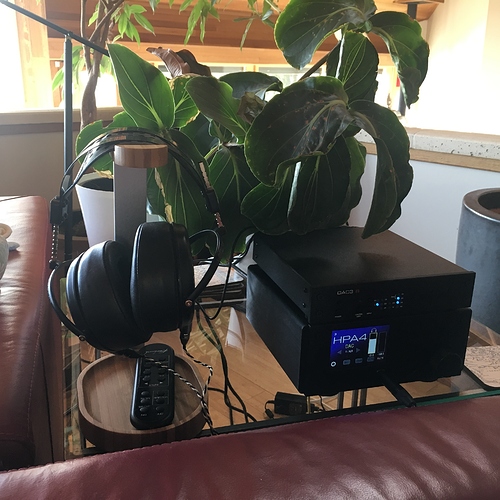(Fair warning: another long, philosophizing piece.)
In the 80s, I became convinced that the front and back ends of the chain were the most difficult to get right, and therefore the most important to focus on and invest in: the transducers that convert between mechanical and electrical energy, the cartridge (and its supporting arm and turntable) at the input end, and the speakers (and their interaction with the room) at the output end. And consequently, I felt that the all-electronic chain in-between (pre-pre-amp, pre-amp, amp…) was under control; I would not argue that all amps sound the same, but I felt that any competently engineered electronics box was close enough to perfection that it wasn’t worth worrying about.
I have held on to this belief: I don’t do vinyl anymore, but as we often say in these pages, the speakers and room (and DSP room correction) are the second most important component. (The most important is the music, and hence Roon which helps me discover and explore and traverse the music and musicians.)
I didn’t pay much attention to amps. Unless they were underpowered or just bad, they were not a worry.
Today it seems as if people here and elsewhere consider the digital chain the most critical. There is an enormous amount of attention paid to DACs and their technology, and to the stuff around them, formats and streaming and jitter and clocks and cables and switches and their power supplies. This is a little weird: digital technology is certainly more robust than analog, much less sensitive to disturbances. Maybe people think of the DAC as a transducer, sort of, like a vinyl cartridge, converting between one form of information and another, and hence difficult. Maybe people think this is still an immature technology (but it’s been 30years!). Maybe it’s just cool. Maybe the interest is self-reinforcing, with all the talk in media and all the new tech like audiophile USB cables, LPS for network switches, femto clocks sprinkled all over the place. I have shared in these views, but I do so less and less: as before with amps, I feel the industry knows how to build a competent DAC and much of the ancillary stuff has minimal effect.
But a few observations conspired to make me question the belief in amps as being mature. I listen to headphones a lot, and I had noticed that many DACs included a headphone amp that they didn’t pay any attention to, that they didn’t charge appreciably for, and that as we might expect sounded like crap. This was especially true at the lower end: it is difficult to buy a cheap DAC without a headphone jack. (At higher prices, pure DACs are more common, perversely.) I have owned several of these devices, and gotten rid of them. And conversely, I have owned single-purpose, analog headphone amps that were much better.
And then came the breakthrough: a friend recommended the THX AAA 789 headphone amp (technology invented by THX, box sold by Massdrop). I have written about it Really low cost headphone endpoint : it is stunningly good, and it cost $350. This shook me: the part that I have considered mature and competent was suddenly revolutionized. I use that word advisedly: the 789 is not just good, it’s revolutionary.
I needed to get a DAC for it, and I tried to be price-appropriate. A $10,000 Chord stack in front of a $350 amp didn’t seem right. An $80 DAC by Grace worked but didn’t satisfy. I got an SMSL SU-8 for $200, it works well with the amp.
But I wanted to go further. Turns out Benchmark has licensed a more advanced version of the THX technology, added some nice stuff of their own like a relay-based volume control, and sell the HPA4 headphone amp. It plays well with the “B” version of the DAC3 which does not include the lesser headphone amp and volume control: they use professional level balanced connection at 16 dB higher than unbalanced consumer stuff, improving SNR. (Several white papers at the web site.) The combo costs $3,700, 10X more than the 789 but a lot less than a Chord DAVE.
I use Audeze LCD-4z cans. The combination is fascinating.
And it’s interesting: the Benchmark DAC is certainly well engineered and well respected, but it’s based on a common ESS chip and not even the top of the line. It doesn’t use custom code in an FPGA like Chord’s and PSAudio’s stuff, it doesn’t brag of a million taps. It fits in my old view of a competently engineered box, but not necessarily earth-shaking. The key thing is, I let the choice of headphone amp guide the choice of DAC, instead of the other way around. Listening to the rig right now, I feel this was a reasonable choice.
Tail wagging the dog. Very cool.
With four components — the DAC3B and the HPA4 Benchamrks, and the 789 and the DU-8 — I could of course do a comparison of combinations. And I could introduce Chord and Meridian DACs, and the Bryston headphone amp. But I’m not a reviewer, look elsewhere.
This post is not about reviewing devices. It’s about new technology revising a long held belief.
I think it’s good when we are flexible and open to reviewing old beliefs.
